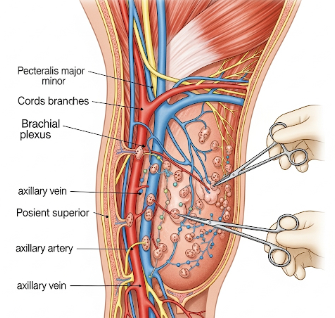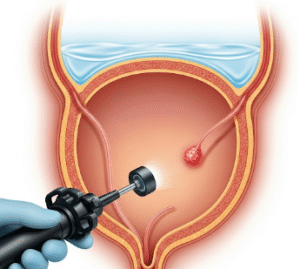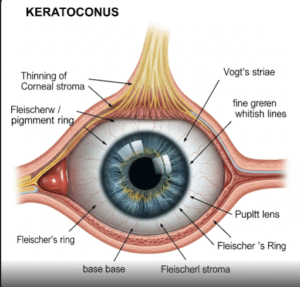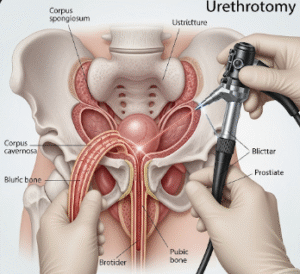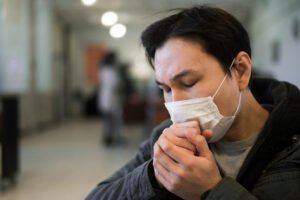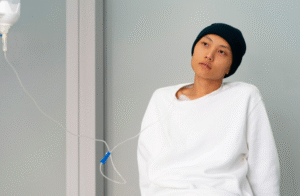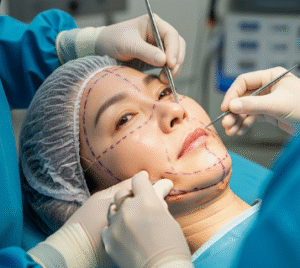Overview
Axillary Node Clearance (ANC) is a surgical procedure to remove lymph nodes from the underarm (axilla), primarily performed in patients with breast cancer or other cancers that may spread via the lymphatic system. The procedure helps determine the extent of cancer spread and may also reduce the risk of regional recurrence.
In Korea, ANC is performed in state-of-the-art oncology centers by highly skilled surgical oncologists, with advanced imaging and intraoperative guidance to ensure optimal outcomes and minimal complications. Postoperative care includes wound management, physiotherapy, and monitoring for lymphedema.
What is Axillary Node Clearance?
Axillary node clearance involves the surgical removal of axillary lymph nodes, which are located under the arm near the breast. The procedure can be:
- Level I & II Node Clearance:
- Removal of lymph nodes from lower (Level I) and mid-axilla (Level II)
- Usually performed in early-stage breast cancer with positive sentinel nodes
- Level III Node Clearance (less common):
- Removal of upper axilla nodes near the chest wall and under the clavicle
- Performed if cancer spread is extensive
Key points:
- Provides accurate staging for breast cancer
- Helps guide postoperative treatment such as chemotherapy or radiotherapy
- Aims to reduce regional recurrence risk
- Often combined with breast-conserving surgery or mastectomy
What are the benefits?
- ✅ Accurate cancer staging, guiding further treatment
- ✅ Reduces regional recurrence by removing affected nodes
- ✅ Helps determine need for adjuvant therapies
- ✅ Provides peace of mind regarding cancer spread
- ✅ In Korea, experienced surgeons minimize complications such as nerve injury and lymphedema
Procedure Details
1) How should I prepare for Axillary Node Clearance?
- ➤ Preoperative evaluation: Blood tests, imaging (ultrasound, MRI, or PET scan)
- ➤ Discuss current medications, allergies, and medical history
- ➤ Fasting instructions if general anesthesia is planned
- ➤ Pre-surgery counseling about procedure, risks, recovery, and postoperative care
- ➤ Plan for postoperative physiotherapy and limb care to reduce lymphedema
2) What happens during the procedure Axillary Node Clearance?
- ✅ Performed under general anesthesia
- ✅ Incision made in the underarm area to access axillary lymph nodes
- ✅ Lymph nodes are carefully dissected and removed, preserving key structures such as nerves and blood vessels when possible
- ✅ Specimens sent for histopathology to assess cancer involvement
- ✅ Incision is closed with sutures or surgical staples and a drain may be placed to prevent fluid accumulation
- ✅ Duration: Typically 1–2 hours, depending on the extent of clearance
3) What happens after Axillary Node Clearance?
- ➤ Patients monitored in recovery and surgical ward
- ➤ Pain management with medications
- ➤ Drain management: Usually removed within 1–2 weeks once output decreases
- ➤ Early physiotherapy and arm exercises to restore mobility
- ➤ Wound care to prevent infection
- ➤ Follow-up for lymphedema monitoring and adjuvant cancer treatment
Risks / Benefits
Potential Risks:
- ➤ Lymphedema (swelling of the arm due to lymphatic disruption)
- ➤ Infection or wound complications
- ➤ Seroma (fluid accumulation under the arm)
- ➤ Nerve injury causing numbness, tingling, or limited movement
- ➤ Bleeding or hematoma formation
Benefits:
- ✅ Provides definitive cancer staging
- ✅ Reduces risk of regional cancer recurrence
- ✅ Guides postoperative therapy decisions
- ✅ In Korea, meticulous surgical technique minimizes complications and maximizes functional recovery
Recovery and Outlook
- Hospital stay: Usually 2–5 days, depending on extent of surgery and drain management
- Activity: Light arm movement and physiotherapy; avoid heavy lifting initially
- Physiotherapy: Essential for shoulder and arm mobility, reducing risk of stiffness and lymphedema
- Full recovery: Usually 4–6 weeks for wound healing; arm function may improve gradually with exercises
- Lifestyle: Follow arm care instructions, avoid trauma, and maintain healthy lifestyle for cancer recovery
When To Call the Doctor
- ➤ Redness, swelling, or discharge from the surgical site
- ➤ Persistent pain not relieved by medication
- ➤ Signs of lymphedema: swelling, heaviness, or tightness of the arm
- ➤ Fever or systemic symptoms suggesting infection
- ➤ Any new neurological symptoms: numbness, tingling, or weakness
Best Korea Option / Process
- ✅ Korea offers top oncology centers with skilled surgical oncologists
- ✅ Procedures performed with high precision and minimal complications
- ✅ Postoperative care includes drain management, physiotherapy, and lymphedema prevention
- ✅ International patients benefit from VIP services, English-speaking staff, and coordinated oncology care
- ✅ Advanced imaging and surgical techniques ensure accurate staging, safe removal, and optimal outcomes

